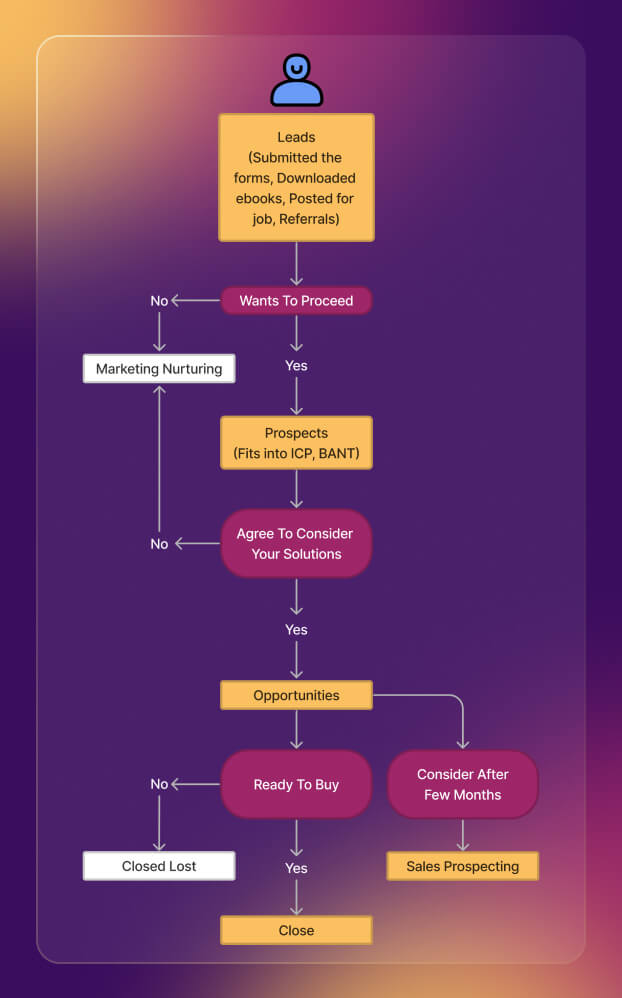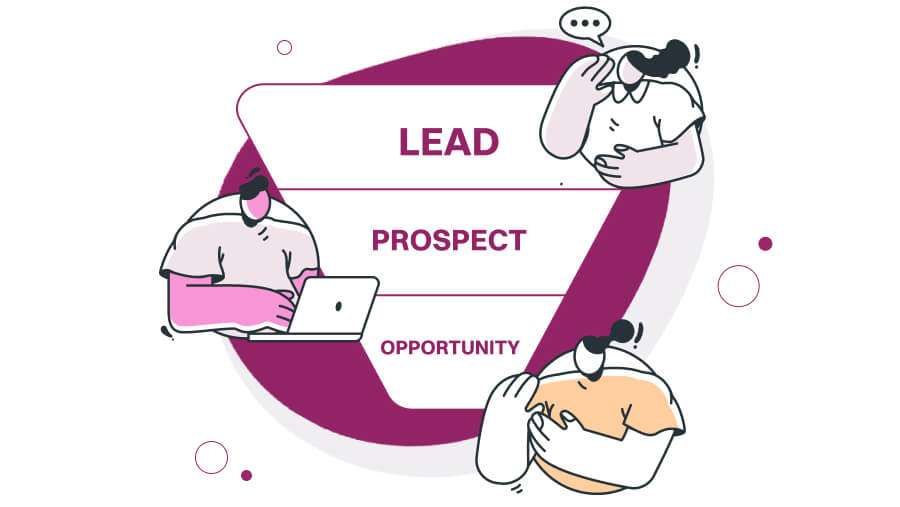
Lead Vs. Prospect Vs. Opportunity: The Best Transition Guide
Can you tell what refines sales targeting, enables tailored outreach strategies, and fosters meaningful connections with your potential customers?
Any guesses?
It's understanding the nuances among your leads, prospects, and opportunities.
You may waste your marketing and sales efforts if you can't tell who a lead and potential customer is. Knowing the differences helps you approach them correctly to push them ahead in the sales funnel.
Doing so becomes more important as 79% of marketing leads never convert to sales. The reason is the lack of the proper approach that transitions right leads into prospects and sales opportunities.
Doing it in-house or selecting an outsourced lead gen partner can help you get the right professionals to drive transitions.
However, if you’re planning to establish an in-house systematic process, then you are at the right place. Our guide will walk you through the basics and practical tips.
Let us begin.

What Are B2B Leads?
B2B leads refer to an organization or individual interested in your product or service. However, they may not be your potential customers yet. Thus, as per the lead classification system, you can call these leads as warm leads
You can identify them through your marketing efforts as they often enter the sales funnel after:
- Responding to your marketing campaigns
- Engaging with content
- Showing interest in a product or service
These leads are called Marketing Qualified Leads (MQLs).
Hence, your marketing team nurtures these business leads at the top of the funnel for eventual closing. They achieve this by actively:
- Sharing relevant information (Depending on the content leads' interact with the most)
- Sending nurturing emails, warm calls, and LinkedIn InMails
Among these MQLs, your focus should be on the potential paying customers.
Thus, you need to further qualify your leads for prospecting.
Lead Classification
The Transition of a Lead to a Prospect
Leads who progress through your sales funnel become your sales leads or prospects or potential customers. They respond positively to your nurturing efforts. Plus, they are likely to derive value from your product, displaying a genuine interest, and are poised for a potential purchase.
However, they must pass the sales qualification process to put leads into the prospect category. You should evaluate whether your product or service aligns effectively with the specific needs of potential prospects.
The leads to prospects qualification criteria comprise three stages:

| Stage | Description |
| Alignment- qualification |
|
| Benefit-qualification |
|
| Stakeholders-qualification |
|
Use BANT to ensure leads go through all three stages of the qualification method. It stands for
- Budget: Can the prospect afford the product or service?
- Authority: Does the prospect have the decision-making power?
- Need: Is there a genuine need for the product or service?
- Timeline: What is the prospect's intended timeframe for making a decision?
It is one of the best qualification frameworks to find prospects worth pursuing.
Pro Tip- Do not cut ties with the unqualified leads right away. Instead, do the following:
- If an unqualified lead still has needs you can fulfill, propose alternative solutions that better align with their requirements.
- For disqualified leads with future potential, nurture them through ongoing marketing efforts. Send relevant content regularly to build a relationship. After engaging with content, 52% of B2B buyers express the likelihood of purchase.
- Retain unqualified leads' information in your database. Their situation may change, and they may become customers later.
The Transition of Prospect to a Sales Opportunity
An opportunity is just a step away from being your customer. When a prospect strongly demonstrates a readiness to purchase the product, they enter the category of "sales opportunity." They often provide positive and responsive feedback to your sales efforts.
Using BANT while picking prospects (as suggested earlier) will be helpful here.
It improves the rate of prospects converting into opportunities. However, you still need to put in some work here.
First,
Ensure your prospects pass these parameters:
| Parameter | Pain Point | Interest | Fit |
|
Prospect's particular issue your solution can address. |
Prospect’s interest in resolving the issue. |
Prospect’s overall fit with the offering. |
|
|
How to Check |
|
|
|
Those prospects who fulfill the above parameters are your sales opportunities. However, those who couldn't pass the threshold may still hold some potential.
Here's how to lock these cold prospects for future conversion:
1. Keep Learning About Prospects
Your prospects closely align with your ideal customer profile, making them more likely to convert than typical leads. So, stay engaged with them even if they don't come out as opportunities immediately.
You can initiate conversations through warm calls or emails. Keep a note of their evolving needs and challenges. You can use outsourced SDR services to engage with these prospects. It's because they are 14% more effective than inside sales pros. They have better skills to effectively adjust your offerings to address and alleviate prospects' specific concerns.
2. Have a Dedicated Nurturing Program
Dedicated nurturing involves cultivating stronger connections with prospects. Quality content plays a crucial role in this process. Key content types for transforming prospects into opportunities include:
- Relevant quizzes and surveys
- Webinars
- Case studies
- Virtual events or workshops
- Whitepapers
- Video tutorials
- Product demos
- Email sequences
Your prospecting content must:
- Educate prospects about their challenges
- Familiarize them with your offerings
- Demonstrate how your updated features and upgrades can effectively address their issues
3. Keep Consistency
Even after your efforts, some prospects in your sales pipeline may not be ready to buy immediately. And that's perfectly normal.
Stick to the nurturing program and consistently build genuine relationships with your prospects. Investing time to understand them ensures future deals and long-term loyalty.
If you noticed, transitioning from lead to prospect to an opportunity has a common driver. That is constant and relevant content delivery at each phase.
Thus, our experts suggest understanding the positioning of these three entities in your sales funnel. It will help you create and distribute accurate content types to each of them at the right time.
Position of Leads-Prospects-Opportunities in the Sales Funnel
The funnel visually represents your customer journey from the initial awareness stage to purchasing. The funnel starts broad and gradually narrows down as potential buyers move through various stages like this:
%20(1).jpg?width=700&height=542&name=Leads%20to%20Prospects%20Qualification%20Criteria%20(1)%20(1).jpg)
Your goal is to guide them step by step. And provide them with the information and experiences they need to purchase.
For this, learn the positioning of your Lead vs. Prospect vs. Opportunity in the funnel:
| Target Customer Type | Lead | Prospect | Opportunity |
| Funnel Stage Positioning | Awareness (Top of the Funnel) | Consideration (Middle of the Funnel) | Decision (Bottom of the Funnel) |
| Traits | Share demographic, interests, issues, etc. | Pass sales-qualification tests | Show high interest to purchase |
| Needed Content |
|
|
|
Tips to Ensure Smooth Lead Movement Through the Sales Funnel
Here are some additional efforts you can make to ease the entire transition process:
1. Perform Lead Management
Efficiently managing leads is the backbone of a smooth sales funnel. It helps ensure you correctly track, nurture, and guide leads through each stage.
Thus, regularly update and categorize leads based on their engagement. Implement a system to distribute leads to the right marketing and sales representatives promptly.
2. Establish Lead Scoring
The lead scoring method helps you identify and focus on the most active prospects, saving time and resources. It can be a complementary practice to your other lead and prospect qualification frameworks.
Lead scoring involves assigning scores based on the following:
- Lead behavior
- Demographics
- Engagement levels
Set thresholds for different score ranges to determine when a lead is ready to move to the next stage.
3. Leverage Marketing Automation and CRM tools
With automation, you can streamline repetitive tasks. These can include email series delivery and social media posts.
CRM tools like HubSpot, MailChimp, or Salesforce provide a centralized hub for storing customer data and interaction updates. It ensures seamless communication and collaboration across your sales and marketing teams.
Conclusion
A systematic transitioning process is imperative for successfully navigating leads, prospects, and opportunities. You must implement the right qualification frameworks to ensure targeted efforts and increased conversions. Partner with Revnew, the leading lead generation agency, for unparalleled expertise.
Our experts offer the pinnacle in optimizing sales strategies for your sustained business growth. Contact us today to know more.




